Developer Guide

Welcome to the SportsPA Developer Guide!
- Introduction
- Using this Developer Guide
- Acknowledgements
- Setting up, getting started
- Design
- Implementation
- Documentation, logging, testing, configuration, dev-ops
- Appendix: Requirements
- Appendix: Instructions for manual testing
- Appendix: Effort
Introduction
SportsPA is a desktop application for NUS sports CCA Leaders to manage membership and training sessions, optimized for use via a Command Line Interface (CLI), while still preserving the benefits of a Graphical User Interface (GUI).
SportsPA is highly optimized for fast typists and can be fully operated through keyboard commands.
This developer guide is intended to be a one-stop source for anyone interested in extending and modifying SportsPA. For certain terms that are unique to SportsPA, a glossary has been provided for readers.
Using this Developer Guide
You can click on the links in the Table of Contents to quickly navigate to your desired location in
this Developer Guide. A link to return to the Table of Contents is also provided at the end of every section.
The table below summarizes the meaning of the icons and text styles used throughout this Developer Guide.
| Syntax | Description |
|---|---|
| bold | Highlights important information such as components of SportsPA or constraints of command parameters |
| italics | Terms to be defined in the glossary |
Codeblock |
Represents distinct classes, and their methods |
| keyboard | Represents keyboard actions by the user |
| link | Represents links that can be clicked on to navigate to a relevant section of the User Guide or a different website |
| Represents important information to note | |
| Represents useful tips that we would like to share |
Acknowledgements
- Based on AddressBook-Level3 project created by the SE-EDU initiative.
Setting up, getting started
Refer to the guide Setting up and getting started.
![]() Note: Readers are advised to download SportsPA’s latest release to test the application.
Note: Readers are advised to download SportsPA’s latest release to test the application.
Design
.puml files used to create diagrams in this document can be found in
the diagrams folder. Refer to the PlantUML
Tutorial at se-edu/guides to learn how to create and edit
diagrams.
Architecture

The Architecture Diagram given above explains the high-level design of the App.
Given below is a quick overview of main components and how they interact with each other.
Main components of the architecture
Main has two classes
called Main
and MainApp. It
is responsible for,
- At app launch: Initializes the components in the correct sequence, and connects them up with each other.
- At shut down: Shuts down the components and invokes cleanup methods where necessary.
Commons represents a collection of classes used by multiple other components.
The rest of the App consists of four components.
-
UI: The UI of the App. -
Logic: The command executor. -
Model: Holds the data of the App in memory. -
Storage: Reads data from, and writes data to, the hard disk.
Each of the four main components (also shown in the diagram above),
- defines its API in an
interfacewith the same name as the Component. - implements its functionality using a concrete
{Component Name}Managerclass (which follows the corresponding APIinterfacementioned in the previous point.
For example, the Logic component defines its API in the Logic.java interface and implements its functionality using
the LogicManager.java class which follows the Logic interface. Other components interact with a given component
through its interface rather than the concrete class (reason: to prevent outside component’s being coupled to the
implementation of a component), as illustrated in the (partial) class diagram below.
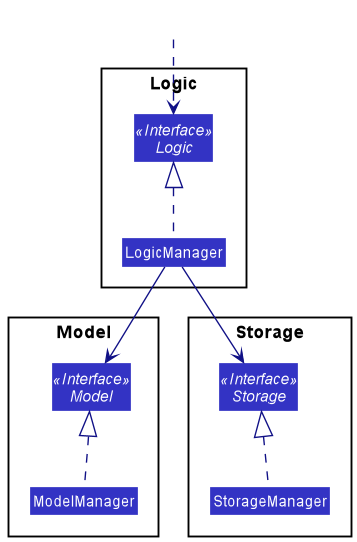
How the architecture components interact with each other
The Sequence Diagram below shows how the components interact with each other for the scenario where the user issues the command deletem 1.

The sections below give more details of each component.
UI component
The API of this component is specified
in Ui.java
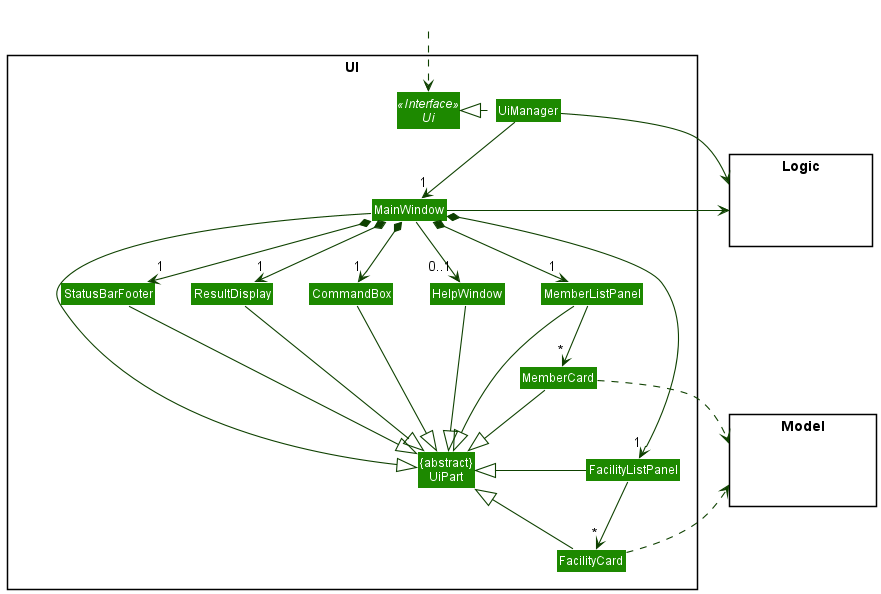
The UI consists of a MainWindow that is made up of parts e.g.CommandBox, ResultDisplay, MemberListPanel
, FacilityListPanel, StatusBarFooter etc. All these, including the MainWindow, inherit from the abstract UiPart class which captures
the commonalities between classes that represent parts of the visible GUI.
The UI component uses the JavaFx UI framework. The layout of these UI parts are defined in matching .fxml files that
are in the src/main/resources/view folder. For example, the layout of
the MainWindow
is specified
in MainWindow.fxml
The UI component,
- executes user commands using the
Logiccomponent. - listens for changes to
Modeldata so that the UI can be updated with the modified data. - keeps a reference to the
Logiccomponent, because theUIrelies on theLogicto execute commands. - depends on some classes in the
Modelcomponent, as it displaysMemberandFacilityobjects residing in theModel.
Logic component
API : Logic.java
Here’s a (partial) class diagram of the Logic component:

How the Logic component works:
- When
Logicis called upon to execute a command, it uses theSportsPaParserclass to parse the user command. - This results in a
Commandobject (more precisely, an object of one of its subclasses e.g.,AddMemberCommand) which is executed by theLogicManager. - The command can communicate with the
Modelwhen it is executed (e.g. to add a member). - The result of the command execution is encapsulated as a
CommandResultobject which is returned back fromLogic.
The Sequence Diagram below illustrates the interactions within the Logic component for the execute("deletem 1") API
call.

DeleteMemberCommandParser should end at the destroy marker (X) but due to a limitation of PlantUML, the lifeline reaches the end of diagram.
Here are the other classes in Logic (omitted from the class diagram above) that are used for parsing a user command:

How the parsing works:
-
SportsPaParserdepends on some classes in theModelcomponent (as it is responsible for identifying and parsing aliases present in a user command). - When called upon to parse a user command, the
SportsPaParserclass creates anXYZCommandParser(XYZis a placeholder for the specific command name e.g.,AddMemberCommandParser) which uses the other classes shown above to parse the user command and create aXYZCommandobject (e.g.,AddMemberCommand) which theSportsPaParserreturns back as aCommandobject. - All
XYZCommandParserclasses (e.g.,AddMemberCommandParser,DeleteMemberCommandParser, …) inherit from theParserinterface so that they can be treated similarly where possible e.g, during testing.
Model component
API : Model.java

The Model component,
- stores the SportsPA data i.e., all
MemberandFacilityobjects (which are contained in aUniqueMemberListand aUniqueFacilityListobject respectively). - stores the currently ‘selected’
MemberandFacilityobjects (e.g., results of a search query) as a separate filtered list which is exposed to outsiders as unmodifiableObservableList<Member>andObservableList<Facility>respectively which can be ‘observed’ e.g. the UI can be bound to this list so that the UI automatically updates when the data in the list change. - stores a
UserPrefobject that represents the user’s preferences. This is exposed to the outside as aReadOnlyUserPrefobjects. - does not depend on any of the other three components (as the
Modelrepresents data entities of the domain, they should make sense on their own without depending on other components)
Facility classes are omitted in this diagram. It has a Tag list in the SportsPA, which Member references. This allows SportsPa to only require one Tag object per unique tag, instead of each Member needing their own Tag objects.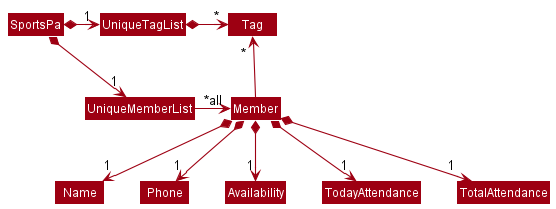
Storage component
API : Storage.java
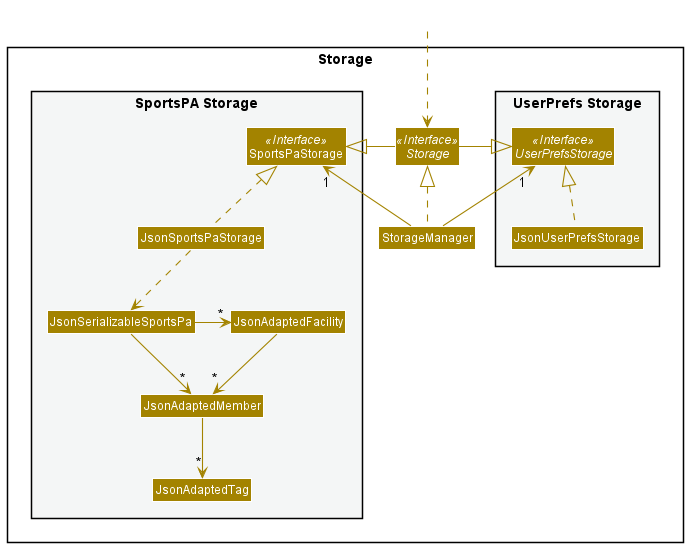
The Storage component,
- can save both SportsPA data (data on members and facilities) and user preference data in json format, and read them back into corresponding objects.
- inherits from both
SportsPaStorageandUserPrefStorage, which means it can be treated as either one (if only the functionality of only one is needed). - depends on some classes in the
Modelcomponent (because theStoragecomponent’s job is to save/retrieve objects that belong to theModel)
Common classes
Classes used by multiple components are in the seedu.address.commons package.
Implementation
This section describes some noteworthy details on how certain features are implemented.
Alias feature
The alias feature creates a shortcut name for any command in SportsPA. The shortcut name must not be an existing command word in SportsPA.
Implementation
The alias mechanism is facilitated by SportsPaParser. Aliases are stored in AliasMap, which keeps the mappings
between Shortcut and CommandWord, and is stored in UserPref. The association between Shortcut and CommandWord
is represented as Alias. The class diagram for AliasMap is shown below.

AliasMap implements the following operations:
-
AliasMap#add(Alias)— Adds an alias to the mapping. -
AliasMap#remove(Shortcut)— Removes an alias from the mapping. -
AliasMap#convertAliasIfPresent(String)— Replaces the input string with the command if it is an alias.
The first two operations are exposed in the Model interface as Model#addAlias(Alias)
and Model#removeAlias(Shortcut) respectively. The last operation is utilised by SportsPaParser to parse aliases used
in a user command. The relevant operation to retrieve the AliasMap is exposed in the Model interface as Model#getAliases().
Given below is an example usage scenario and how the aliases mechanism behaves.
Step 1. The user launches the application for the first time. UserPrefs is initialised and AliasMap is created with
empty mappings.

Step 2. The user executes the alias s/l cw/listf command to create a shortcut l for the listf command. The alias
command calls Model#addAlias(Alias), causing a mapping between l and listf to be stored in AliasMap.

Step 3. The user now wants to use the shortcut l for a different command, listm, instead. The user
executes alias s/l cw/listm. Model#addAlias(Alias) is called again and the mapping from l to listf is replaced
with l to listm in AliasMap.

Step 4. The user enters l, which the system understands as listm and executes the listm command, displaying all members in the member list.
The following sequence diagram shows how the system understands aliases:

Step 5. The user then realises that the shortcut l was not to their liking and deletes the alias by
executing unalias l. The unalias command calls Model#removeAlias(Shortcut) and removes the mapping from AliasMap
.

Step 6. The user finally decides to use the shortcut lm for listm and executes alias s/lm cw/listm. The user
closes the application and the alias defined are saved into UserPrefStorage, available for use at the next launch.
The following activity diagram summarizes what happens when a user enters and executes a command:

Design considerations:
Aspect: What the user can create shortcuts for
-
Alternative 1 (current choice): Valid commands only.
- Pros: Easy to implement in parser.
- Cons: Less flexibility for user.
-
Alternative 2: Any defined text.
- Pros: Very flexible, no validation required.
- Cons: Difficult to parse user input as would need to scan exhaustively for aliases.
In modern CLI applications, an alias is mainly used for abbreviating system commands or adding default arguments to regularly used commands. Considering the target use of SportsPA and time constraints, since command arguments are not likely to be repeated, we decided that it was sufficient to allow users to create shortcuts for commands only.
Split members to facilities feature
The split feature splits members into the facilities based on its capacity and members’ availabilities. The split command only accepts numbers 1-7 as a preamble e.g., split 6 is valid and splits members on Saturday.
Implementation
The split mechanism is facilitated by ModelManager and SportsPa. ModelManager stores a list of
filtered members as filteredMembers. Each Member in the list has an Availability, which is implemented internally as a List<DayOfWeek>.
SportsPa stores a list of all facilities in UniqueFacilityList as facilities. Each Facility in the list has an AllocationMap, which is implemented internally as an EnumMap<DayOfWeek, List<Member>>. This EnumMap is initialized
with 7 key-value pairs, of which the keys are all the enums of the
java.time.DayOfWeek ({MONDAY, TUESDAY, WEDNESDAY, THURSDAY, FRIDAY, SATURDAY, SUNDAY}) and the values are all initialized
as an empty ArrayList to hold the members allocated. This is based on the assumption that facilities are available on every day of the week.
When the split command is executed with a given DAY parameter, all members available on that DAY are filtered and the ArrayList<Member> of all facilities for that DAY is cleared.
The available members are then added to the List<Member> of the corresponding DayOfWeek in the EnumMap of the facilities using a greedy algorithm.
i.e. The filtered members list and facility list are iterated and each Member is allocated to the first Facility which is not at max capacity. After
a Facility is at max capacity, any remaining Members are allocated to the next available Facility and so on.
ModelManager implements the following operation:
-
ModelManager#split(Predicate<Member>, int)— Filters the list of all members according to the givenpredicate.
SportsPa implements the following operation:
-
SportsPa#split(FilteredList<Member>, int)— Splits the members in the given filtered member list into facilities on the given day.
Additionally,
UniqueFacilityList implements the following operation:
-
UniqueFacilityList#allocateMembersToFacilitiesOnDay(FilteredList<Member>, int)— Clears theAllocationMapof eachFacilityand allocates the members in the given filtered member list to facilities greedily. -
Facilityimplements the following operation: -
Facility#addMemberToFacilityOnDay(Member, DayOfWeek)— Adds the given member toAllocationMapon the given day.
Given below is an example usage scenario and how the split feature behaves at each step.
Step 1. The user launches the application for the first time. The user then adds 5 members into an empty SportsPA
by executing the addm command 5 times with the parameter d/1 (all required parameters are provided as well but not specified here).
Each Member in the filteredMembers list will have an availability of Monday.
The user then adds 1 facility into SportsPA by executing the addf command with the parameter c/5
(all required parameters are provided as well but not specified here). The Facility in the facilities list will
have a capacity of 5 and an AllocationMap with all the values initialized as an empty ArrayList.
Step2. The user executes split 1 command to split the 5 members in the filtered list to facilities on Monday. The split command
creates a MemberAvailableOnDayPredicate with the given day and passes it and the given day to ModelManager#split(Predicate<Member>, int).
ModelManager then creates a filtered list of members who are available on Monday. It then calls SportsPa#split(FilteredList<Member>, int), passing to it
the filtered list and the given day. SportsPA then iterates through the 5 members in the filtered member list and the 1 facility in its UniqueFacilityList, calling
Facility#addMemberToFacilityOnDay(Member, DayOfWeek). This adds the 5 members to the ArrayList of the AllocationMap of the Facility for Monday.
The following sequence diagram shows how the split mechanism works.

The following activity diagram summarizes what happens when a user executes the split command:

Design considerations:
Aspect: Format of values in Availability
-
Alternative 1 (current choice): Store values as
java.time.DayOfWeek.- Pros: Easy to implement in parser, increases user-friendliness by allowing users to just type in numbers to
represent days of a week instead of the names. Numbers can then be easily converted into
DayOfWeekand formatted to get consistent display name formats. Easily sorted in the natural order of the days of a week, ensuring uniformity when displayed and making it easier to read. - Cons: May not be intuitive to some users that 1 represents Monday and 7 represents Sunday.
- Pros: Easy to implement in parser, increases user-friendliness by allowing users to just type in numbers to
represent days of a week instead of the names. Numbers can then be easily converted into
-
Alternative 2: Store values as
String- Pros: Intuitive for users to type in the names of the days which can be stored directly after parsing.
- Cons: Difficult to parse user input as a complicated regular expression is needed to ensure names of days are given in the correct format. Less user-friendly due to need to type out the names of the days and more difficult to sort.
Aspect: Algorithm used to determine allocation
-
Alternative 1 (current choice): Greedy algorithm.
- Pros: Easy to implement and test. Intuitive and produces results similar to manual allocation.
- Cons: Can only produce 1 allocation mapping for a set of Member and facilities with the same availabilities and capacities, which may not be ideal.
-
Alternative 2: Other algorithms.
- Pros: Possible increase in performance and able to produce multiple different mappings.
- Cons: Harder to implement and test. May require the use of supporting data structures which adds on to the complexity.
Mark/unmark attendance feature
The mark attendance feature marks the attendance of the members at the specified index/indices of the member list as present.
The unmark attendance feature unmarks the attendance of the members at the specific index/indices of the member list to be absent.
Implementation
The mark/unmark attendance mechanism is facilitated by ModelManager. The ModelManager stores a list of filtered members
as filteredMembers. Each Member in the list internally stores totalAttendance and todayAttendance
which will be updated accordingly when the attendance of that Member is marked or unmarked.
ModelManager implements the following operations:
-
ModelManager#markMembersAttendance(List<Index>)— Marks attendance of members at the specified list of index. -
ModelManager#unmarkMembersAttendance(List<Index>)— Unmarks attendance of members at the specified list of index as absent. -
ModelManager#markOneMemberAttendance(Member)— Marks attendance of specified member. -
ModelManager#unmarkMembersAttendance(Member)— Unmarks attendance of specified member. -
ModelManager#isWithinListIndex(List<Index>)— Checks if given indices are valid.
Additionally, Member implements the following operations:
-
Member#setPresent()— SetstodayAttendanceas present and incrementstotalAttendance -
Member#setNotPresent()— SetstodayAttendanceas not present and decrementstotalAttendance
Given below is an example usage scenario and how the mark/unmark attendance feature behaves at each step.
Step 1. The user launches the application for the first time. The user then adds 2 members into an empty SportsPA
by executing the addm command. Each Member in the filteredMembers list will be initialized with their initial
todayAttendance and totalAttendance.
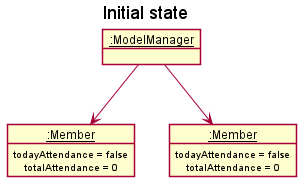
Step 2. The user executes mark 1 2 command to mark the members at index 1 and 2 in the filtered list as present. The mark command
first checks if the given indices 1 and 2 are within the displayed list of members via the ModelManager#isWithinListIndex(List<Index>). Then
if all indices are valid,ModelManager#markMembersAttendance(List<Index>) is then called. This then calls ModelManager#markOneMemberAttendance(Member) to increment todayAttendance
and totalAttendance of the Member at the 1st and 2nd index in the list by calling Member#setPresent() for each Member. The newly editedMembers with the updated attendance are now referenced by ModelManager.

The following sequence diagram shows how the mark attendance operation works.

The unmark command does the opposite — it calls the ModelManager#unmarkMembersAttendance(List<Index>), which then
calls the ModelManager#unmarkMembersAttendance(Member) which decrements the totalAttendance and todayAttendance of the Member
to be unmarked via the Member#setNotPresent() and ModelManager references the newly modified Members.
The following activity diagram shows what happens when a user executes the mark command.

Design considerations:
Aspect: How mark & unmark executes
-
Alternative 1 (current choice): Uses index to mark attendance.
- Pros: Easy to implement (e.g there will be no two members with the same index in list, so there will be no ambiguity)
- Cons: May require additional step of finding members’ index using findm command then marking attendance.
-
Alternative 2: Uses names of members to mark attendance.
- Pros: Requires one less step of finding members.
- Cons: There may be two members with same name, so when marking using names, it might result in ambiguity of whose attendance to mark.
Find member feature
The find member feature finds and displays all members that match the parameters specified. At least one valid parameter must be supplied.
Implementation
The find member mechanism is facilitated by FindMemberCommandParser.
FindMemberCommandParser implements the following operations:
-
FindMemberCommandParser#generatePredicate— Generates the final predicate to be used for FindMemberCommand. -
FindMemberCommandParser#generateNamePredicate— Generates the unique name predicate. -
FindMemberCommandParser#generatePhonePredicate— Generates the unique phone predicate. -
FindMemberCommandParser#generateTagPredicate— Generates the unique tag predicate. -
FindMemberCommandParser#generateAvailabilityPredicate— Generates the unique availability predicate. -
FindMemberCommandParser#generateTodayAttendancePredicate— Generates the unique today attendance predicate. -
FindMemberCommandParser#generateTotalAttendancePredicate— Generates the unique total attendance predicate.
The last six operations are facilitated by each attribute’s unique Predicate class, the predicates generated are then chained together in FindMemberCommandParser#generatePredicate using the Predicate#and method.
The final Predicate to filter the member list with is stored in MemberMatchesKeywordsPredicate, which is subsequently passed to the FindMemberCommand class to be executed.
Lastly, the filtered member list is displayed through Model#updateFilteredMemberList(Predicate)
Given below is an example usage scenario and how the find member mechanism behaves.
Step 1. The user executes the findm t/exco command to find all members with the tag exco
Step 2. LogicManager calls SportsPaParser#parseCommand and creates a new FindMemberCommandParser.
Step 3. FindMemberCommandParser#parse is called to parse the argument t/exco.
Step 4. Since t/exco is a valid argument,FindMemberCommandParser#generatePredicate is called.
Step 5. The system recognises the t/ prefix and calls on the FindMemberCommandParser#generateTagPredicate to generate a unique tag predicate from exco.
Step 6. The unique tag predicate is returned in the FindMemberCommandParser#generatePredicate method and then chained together via the Predicate#and method.
Step 7. A new MemberMatchesKeywordPredicate object is created to store the final predicate.
Step 8. The MemberMatchesKeywordPredicate object is passed to FindMemberCommand.
Step 9. FindMemberCommand is then executed through FindCommand#execute.
Step 10. FindMemberCommand will update the member list using the Model#updateFilteredMemberList method.
Step 11. Lastly, a new CommandResult is returned to the LogicManager.
The following sequence diagram shows how the find member operation works:
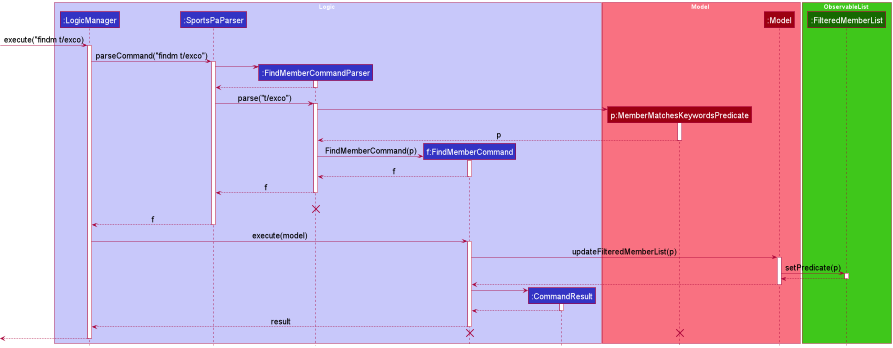
The following activity diagram summarizes what happens when a user enters and executes a find member command:

Design considerations
Aspect: Implementation of the find member command
-
Alternative 1 (current choice): The find member command can search for members with multiple attributes.
- Pros: Allows users to find members in a more precise manner e.g. Users can find members who are available on Monday and are EXCO members.
- Cons: More complex implementation due to parsing multiple prefixes and chaining predicates, thus this alternative is more prone to bugs.
-
Alternative 2: The find member command can search for members with only one attribute.
- Pros: Simpler to parse a single prefix and thus less prone to bugs
- Cons: Compromising user experience as finding a member with only one attribute may generate a large list if there are many matching members.
Import members feature
The import feature allows users to add and update the details of multiple members without having to repeatedly do so individually.
Implementation
The import member mechanism is facilitated by ModelManager and SportsPa. ModelManager has access to SportsPA’s
data from the SportsPa object, from which member data will be read from when the import command is requested by the user.
Before going further, here are some terms used that you should take note of:
- “invalid import” in this context refers to an imported member having the same name as an existing member AND the same phone number as another existing member.
- “valid import” in this context refers to an imported member not having the same name as an existing member AND the same phone number as another existing member.
ModelManager implements the following relevant operations:
-
ModelManager#isValidImport(Member)— Checks if the member being imported is a valid import. -
ModelManager#hasMember(Member)— Returns true if a member with the same name or phone as the given member exists in SportsPA. -
ModelManager#setMember(Member target, Member editedMember)— Replaces the target member in the list with an edited member.
Given below is an example usage scenario and how the import mechanism behaves.
Step 1. The user launches the application for the first time. The user then executes the command addm n/Bob p/12345678, which adds a member called Bob with a phone number 12345678 into the member list.
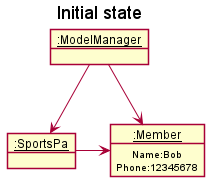
Step 2. The user then realises he has many more members to add and wants to use the import command. He prepares a CSV file
called myFile.csv to import the members from.

Step 3. The user executes the command import myFile.csv to import the members from the CSV file. The import command first
parses the CSV file using a private method ImportCommand#parseCsv(), which returns a list of Member objects to be imported.
After which, the command iterates through the list of Member objects. Each iteration goes as such:
I. A check is done to see if each Member is a valid import by calling ModelManager#isValidImport(Member). If it is a
valid import, go to the next step. Else, the current iteration is skipped and a list of skipped members is kept and will be
shown to the user via the GUI.
In this case, both Member objects are valid imports and can be imported.
II. Then, ModelManager#hasMember(Member) is called to check if there are any members in SportsPA with the same name
or phone as the member being imported. If there is such a member in SportsPA, Then the existing member details in SportsPA
will be updated by the imported member details by calling ModelManager#setMember(Member target, Member editedMember).
Else, the imported member is simply added into SportsPA.
In this case, there is 1 member being imported named Bob while there already exists a member called Bob in SportsPA. So, the existing member, Bob’s details will be updated to the details from the CSV file. As for Amy, the details would be added into SportsPA.
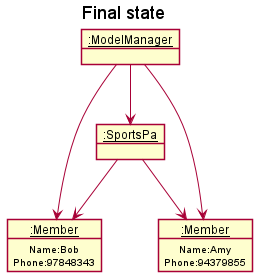
The following sequence diagram shows how the import command works.
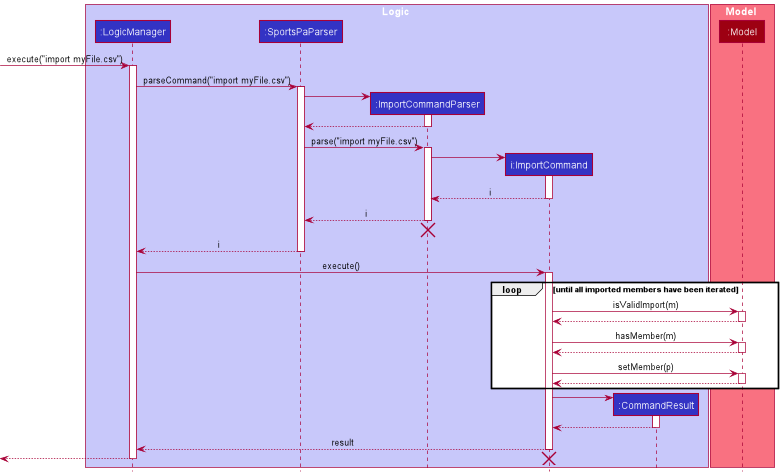
The following activity diagram summarizes what happens when a user executes the import command:

Design Considerations:
Aspect: how to deal with invalid imports
-
Alternative 1 (current choice): Skip the invalid imports and notify the user of the invalid imports.
- Pros: Easy to implement and users will be able to know which imports they need to rectify.
- Cons: Might not be the desired interaction users want.
-
Alternative 2: Treat the command as an invalid command.
- Pros: Easy to implement
- Cons: User might want to import the valid imports and the invalid imports might just be an error on their part.
Documentation, logging, testing, configuration, dev-ops
Appendix: Requirements
Product scope
Target user profile:
- a NUS Sports CCA leader
- has a need to manage a significant number of member’s contacts
- has a need to organise training sessions in multiple facilities whilst adhering to group size regulations
- can type faster than average
- is reasonably comfortable using CLI apps
Value proposition:
- Sports CCAs have many members and it can be hard for the leaders to keep track of everyone’s information and availability to organise training sessions, especially with the current pandemic restrictions.
- SportsPA will help NUS Sports CCA leaders to be able to better manage their members’ contacts and attendance as well as training facilities to better organise CCA sessions.
User stories
Priorities: High (must have) - * * *, Medium (nice to have) - * *, Low (unlikely to have) - *
| Priority | As a … | I want to … | So that I can… |
|---|---|---|---|
* * * |
sports CCA leader | add a new member | keep track of that member’s details |
* * * |
sports CCA leader | view all the members added | so that I can see the list of members in my club |
* * * |
sports CCA leader | delete a member | remove details of that member that is no longer in the CCA |
* * * |
sports CCA leader | add a facility | keep track of that facility’s details |
* * * |
sports CCA leader | view all the facilities added | so that I can see the list of facilities available for use |
* * * |
sports CCA leader | delete a facility | remove details of that facility that are no longer relevant |
* * * |
sports CCA leader | record a facility’s capacity | see how many members can train there while complying with the group size regulations |
* * * |
sports CCA leader | record a members’ availability | see which members are available to attend a training session held on a certain day |
* * * |
sports CCA leader | split available members into the facilities | easily plan training sessions for that day while complying with the group size regulations |
* * |
potential user exploring the app | see the app populated with user data | see how the app works when its in use |
* * |
new user | see usage instructions | refer to instructions when I forget how to use the app |
* * |
new user ready to use the app | purge all current data | get rid of sample/experimental data I used when exploring the app |
* * |
sports CCA leader | edit a member’s details | directly make changes to that member’s details if required |
* * |
sports CCA leader | edit a facility’s data | quickly update the maximum capacity of each facility when group size regulations have changed |
* * |
sports CCA leader | find a member by name | locate relevant members and see their details without having to go through the entire list |
* * |
sports CCA leader | find a facility by location | locate relevant facilities and see their details without having to go through the entire list |
* * |
sports CCA leader | mark my member’s attendance | keep track of who attended today’s training session |
* * |
sports CCA leader | unmark my member’s attendance | correct my mistake if I accidentally marked a member who did not attend the session as present |
* * |
sports CCA leader | see the attendance record of each member | assess their level of commitment |
* * |
sports CCA leader | manually edit a member’s allocation to a facility | accommodate last minute changes or requests made by members |
* * |
sports CCA leader | tag my members | group them into useful categories, such as members with leadership positions or freshmen |
* * |
sports CCA leader | filter members by tags | view all members associated to a given category, such as members with leadership positions |
* * |
sports CCA leader | update members’ availabilities in one go | set members’ availability at once if they are similar instead of individually updating them one-by-one |
* * |
user with many members added into the app | sort members by name | locate a member easily |
* * |
expert user | create shortcut for commands | personalise command words based on my preferences |
* * |
sports CCA leader | import members’ data | get members to fill in their details first, then add the collated data into the application at one go |
* * |
sports CCA leader | export allocations into a readable format | share with members their allocated training session and venue |
* |
user | undo actions | salvage any accidental deletion of data |
* |
sports CCA leader | hide private contact details | minimise the chance of someone else seeing them by accident |
* |
graduating sports CCA leader | transfer my app’s data to someone else | hand over my responsibilities to the next leader of the club |
* |
sports CCA leader | archive temporary data | prevent getting distracted by irrelevant data (e.g. facilities that are temporarily unavailable) |
* |
sports CCA leader | unarchive archived data | view the necessary data again when relevant (e.g. facilities that are back in use) |
* |
sports CCA leader | delete groups of people | remove all graduating members from the app in one go |
* |
long time user | create shortcut for tasks | save time on frequently performed tasks |
Use cases
(For all use cases below, the System is SportsPA and the Actor is the user, unless specified otherwise)
Use case: UC01 - Get help
MSS
- User requests for help
- SportsPA displays instructions on accessing the help page
-
User navigates to the help page
Use case ends.
Use case: UC02 - Add a member
MSS
- User requests to add a member into SportsPA
-
SportsPA adds the member
Use case ends.
Extensions
-
1a. The given field(s) are invalid
-
1a1. SportsPA shows an error message
Use case resumes from step 1.
-
-
1b. The given member already exists in SportsPA
-
1b1. SportsPA shows an error message informing the user about the duplicate
Use case ends
-
Use case: UC03 - List all members
MSS
- User requests to list members
-
SportsPA shows a list of all the members
Use case ends.
Extensions
-
1a. The member list is empty
-
1a1. SportsPA shows an error message
Use case ends.
-
Use case: UC04 - Search for members
MSS
- User requests to search for members by the given field(s)
-
SportsPA shows the list of members matching the given request
Use case ends.
Extensions
-
1a. The given field(s) are invalid
-
3a1. SportsPA shows an error message
Use case resumes from step 1.
-
-
1a. No members have fields matching the given request
-
1a1. SportsPA informs user
Use case ends.
-
Use case: UC05 - Delete a member
MSS
- User requests to list members (UC03) or search for members (UC04)
- User requests to delete a specific member in the list
-
SportsPA deletes the member
Use case ends.
Extensions
-
1a. The list is empty
-
1a1. SportsPA shows an error message
Use case ends.
-
-
2a. The given index is invalid
- 2a1. SportsPA shows an error message
-
2a2. User enters a valid index
Use case resumes from step 2.
Use case: UC06 - Edit a member’s details
MSS
- User requests to list members (UC03) or search for members (UC04)
- User requests to edit the details of specific member in the list
-
SportsPA edits the details of the member
Use case ends.
Extensions
-
1a. The list is empty
-
1a1. SportsPA shows an error message
Use case ends.
-
-
2a. The given index is invalid
-
2a1. SportsPA shows an error message
-
2a2. User enters a valid index
Use case resumes from step 2.
-
-
2b. The given field(s) are invalid
-
2b1. SportsPA shows an error message
-
2a2. User enters the valid field(s)
Use case resumes from step 2.
-
Use case: UC07 - Sort all members
MSS
- User requests to sort all the members by a field
-
SportsPA sorts the members accordingly
Use case ends.
Extensions
-
1a. The given field is invalid
-
1a1. SportsPA shows an error message
Use case ends.
-
Use case: UC08 - Set member(s) availability
MSS
- User requests to list members (UC03) or search for members (UC04)
- User requests to set availability of specific member(s) in the list
-
SportsPA updates the availability of the given member(s)
Use case ends.
Extensions
-
1a. The list is empty
- 1a1. SportsPA shows an error message
Use case ends.
-
2a. One or more of the given member index is invalid
-
2a1. SportsPA shows an error message
-
2a2. User enters valid index
Use case resumes from step 2.
-
-
2b. The given availability is invalid
-
2b1. SportsPA shows an error message
-
2b2. User enters a valid availability
Use case resumes from step 2.
-
Use case: UC09 - Mark attendance of members
MSS
- User requests to list members (UC03) or search for members (UC04)
- User requests to mark the attendance of specific member(s) in the list
-
SportsPA marks the attendance of the specified member(s)
Use case ends.
Extensions
-
1a. The list is empty
- 1a1. SportsPA shows an error message
Use case ends.
-
2a. One or more of the given member index is invalid
-
2a1. SportsPA shows an error message
-
2a2. User enters the valid index
Use case resumes from step 2.
-
Use case: UC10 - Unmark attendance of members
This use case is similar to that of mark attendance (UC09).
Use case: UC11 - Import member details from a CSV file
MSS
- User requests to import member details from a CSV file
-
SportsPA adds all members in the CSV file
Use case ends.
Extensions
-
1a. The CSV file does not exist
-
1a1. SportsPA shows an error message
Use case ends.
-
-
1b. The content of CSV file is not in the valid format
-
1b1. SportsPA shows an error message
Use case ends.
-
-
1c. There are some imported members that have the same name or same phone
-
1c1. SportsPA updates the details of those members using data from the CSV file
Use case ends.
-
Use case: UC12 - Clear all entries in member list
MSS
- User requests to clear all entries in member list
-
SportsPA deletes all the existing members in the member list
Use case ends.
Extensions
-
1a. The member list is empty
-
1a1. SportsPA shows an error message
Use case ends.
-
Use case: UC13 - Add a facility
MSS
- User requests to add a facility into SportsPA
-
SportsPA adds the facility
Use case ends.
Extensions
-
1a. SportsPA detects missing or invalid field(s)
-
1a1. SportsPA shows an error message
-
1a2. User enters valid field(s)
Use case resumes from step 1.
-
Use case: UC14 - List all facilities
MSS
- User requests to list facilities
-
SportsPA shows a list of all the facilities
Use case ends.
Extensions
-
1a. The facility list is empty
-
1a1. SportsPA shows an error message
Use case ends.
-
Use case: UC15 - Search for facilities
MSS
- User requests to find facilities by location(s)
-
SportsPA shows the list of facilities whose locations match the request
Use case ends.
Extensions
-
1a. The facility list is empty
-
1a1. SportsPA shows an error message
Use case ends.
-
-
1b. No facilities have locations matching the request
-
1b1. SportsPA informs user
Use case ends.
-
Use case: UC16 - Delete a facility
MSS
- User requests to list facilities (UC14) or search for facilities (UC15)
- User requests to delete a specific facility in the list
-
SportsPA deletes the facility
Use case ends.
Extensions
-
1a. The facility list is empty
-
1a1. SportsPA shows an error message
Use case ends.
-
-
2a. The given index is invalid
-
2a1. SportsPA shows an error message
-
2a2. User enters the valid index
Use case resumes from step 2.
-
Use case: UC17 - Edit a facility’s details
MSS
- User requests to list facilities (UC14) or search for facilities (UC15)
- User requests to edit the details of specific facility in the list
-
SportsPA edits the details of the facility
Use case ends.
Extensions
-
1a. The list is empty
Use case ends.
-
2a. The given index is invalid
-
2a1. SportsPA shows an error message
-
2a2. User enters the valid index
Use case resumes from step 2.
-
-
2b. SportsPA detects invalid field(s)
-
2b1. SportsPA shows an error message
-
2b2. User enters the valid field(s)
Use case resumes from step 2.
-
Use case: UC18 - Split members into facilities
MSS
- User requests to split available members into the facilities on a specified day
-
SportsPA shows the allocation results
Use case ends.
Extensions
-
1a. SportsPA detects insufficient capacity to allocate all available members
-
1a1. SportsPA shows an error message
Use case ends.
-
-
1b. SportsPA detects no available members
-
1b1. SportsPA shows an error message
Use case ends.
-
Use case: UC19 - Deallocate a member from a facility
MSS
- User requests to list members (UC03) or search for members (UC04)
- User requests to list facilities (UC14) or search for facilities (UC15)
- User requests to deallocate a specified member from a specified facility on a specified day.
-
SportsPA deallocates the specified member from the specified facility on a specified day.
Use case ends.
Extensions
-
3a. One or more of the given indices are invalid
-
3a1. SportsPA shows an error message
-
3a2. User enters the valid index
Use case resumes from step 3.
-
-
3b. The given day is invalid
-
3b1. SportsPA shows an error message
-
3b2. User enters a valid day
Use case resumes from step 3.
-
-
3c. The specified member is not allocated to the specified facility
-
3c1. SportsPA shows an error message
-
3c2. User enters a member that is allocated to that facility
Use case resumes from step 3.
-
Use case: UC20 - Allocate a member to a facility
MSS
- User requests to list members (UC03) or search for members (UC04)
- User requests to list facilities (UC14) or search for facilities (UC15)
- User requests to allocate a specified member to a specified facility on a specified day
-
SportsPA allocates the specified member to the specified facility on a specified day
Use case ends.
Extensions
-
3a. One or more of the given indices are invalid
-
3a1. SportsPA shows an error message
-
3a2. User enters the valid index
Use case resumes from step 3.
-
-
3b. The given day is invalid
-
3b1. SportsPA shows an error message
-
3b2. User enters a valid day
Use case resumes from step 3.
-
-
3c. The specified member is already allocated to the specified facility.
-
3c1. SportsPA shows an error message
-
3c2. User enters a member that is not allocated to that facility
Use case resumes from step 3.
-
Use case: UC21 - Export facility details and member allocations
MSS
- User requests to export facility details and member allocations
-
SportsPA exports the facility details and member allocations to a CSV file
Use case ends.
Use case: UC22 - Clear all entries in facility list
MSS
- User requests to clear all entries in facility list
-
SportsPA deletes all facilities
Use case ends.
Extensions
-
1a. The facility list is empty
- 1a1. SportsPA shows an error message
Use case ends
Use case: UC23 - Exiting the program
MSS
- User requests to exit the program
-
SportsPA terminates
Use case ends.
Non-Functional Requirements
- Should work on any mainstream OS as long as it has Java 11 or above installed
- Should be able to hold up to 1000 entries (members and facilities) without a noticeable sluggishness in performance for typical usage
- Should be able to process and execute user commands within 3 seconds
- A user with above average typing speed for regular English text (i.e. not code, not system admin commands) should be able to accomplish most of the tasks using commands faster than using a mouse
Glossary
- Mainstream OS: Windows, Linux, Unix, OS-X
- Graphical User Interface (GUI): A user interface that includes graphical representation like buttons and icons for users to interact with
- Command Line Interface (CLI): A text-based user interface that the user interacts with by typing in commands
- JSON : JSON, or JavaScript Object Notation, is a minimal, readable format for structuring data.
- Group size regulations: Maximum allowable group size for sporting activities as specified by Covid-19 regulations
- Fast typists: Types faster than 40wpm (words per minute)
- Alias: A shortcut name for any command in SportsPA
- CCA: In Singapore, a co-curricular activity (CCA), is a non-academic activity that students take part in.
Appendix: Instructions for manual testing
Given below are instructions to test the app manually.
Launch and shutdown
-
Initial launch
-
Download the jar file and copy into an empty folder
-
Double-click the jar file Expected: Shows the GUI with a set of sample contacts. The window size may not be optimum.
-
-
Saving window preferences
-
Resize the window to an optimum size. Move the window to a different location. Close the window.
-
Re-launch the app by double-clicking the jar file.
Expected: The most recent window size and location is retained.
-
Adding a member
-
Adding a new member.
-
Prerequisites: The list of members does not already contain members with the same names and/or phone numbers as those in the test cases below.
-
Test case: addm n/Bob p/12345678
Expected: New member with the same name and phone number is added to the bottom of the list of members. The details of the member are shown in the status message. -
Test case: addm n/Ch@rlie p/45678
Expected: No new member added. Error details are shown in the status message. -
Test case: addm n/Adam p/0b234
Expected: Similar to previous. -
Test case: addm n/Sam p/87654321 followed by addm n/Sam p/23456789
Expected: After the first command, a new member called Sam with the phone number 87654321 is added to the list of members. After the second command, no member is added and error details are shown in the status message. -
Test case: addm n/John p/98765432 followed by addm n/Jane p/98765432
Expected: After the first command, a new member called John with the phone number 98765432 is added to the list of members. After the second command, no member is added and error details are shown in the status message.
-
Deleting a member
-
Deleting a member while all members are being shown.
-
Prerequisites: List all members using the listm command. One or more members are in the list.
-
Test case: deletem 1
Expected: First member is deleted from the list. Details of the deleted member shown in the status message. -
Test case: deletem 0
Expected: No member is deleted. Error details shown in the status message. Status bar remains the same. -
Other incorrect delete commands to try: deletem, deletem x, ... (where x is larger than the list size)
Expected: Similar to previous.
-
Editing a member
-
Edit the details of a member that is being shown in the list.
-
Prerequisites: List all members using the listm command. One or more members are in the list and the list does not contain any members with the same names and/or phone number as those in the test cases below.
-
Test case: editm 1 n/Adam
Expected: First member’s name is changed to Adam. Details of the edited member is shown in the status message. -
Test case: editm 1 n/@dam
Expected: No member details are changed. Error details are shown in the status message. -
Other incorrect delete commands to try: editm, editm x n/Bob p/45678, ... (where x is larger than the list size)
Expected: Similar to previous.
-
Setting member availability
-
Set the availability of one or more members
-
Prerequisites: List all members using the listf command. One or more members are in the list.
- Test case: setm 1 2 3 d/1 2
Expected: The availability of the first 3 members are changed to Monday and Tuesday. The names of members that had their availability changed are shown in the status message. - Test case: setm 1 2 3
Expected: No change in the members’ availability. Error details are shown in the status message. - Other incorrect delete commands to try: setm, setm x d/1, ...
(where x is larger than the list size)
Expected: Similar to previous.
-
Adding a facility
-
Adding a new facility.
-
Prerequisites: The list of facilities does not already contain facilities with the same names and locations as those in the test cases below.
-
Test case: addf n/Court 1 l/Sports Hall t/1500 c/5
Expected: New facility called Court 1 at Sports Hall at 3pm with a capacity of 5 is added to the bottom of the list of facilities. -
Test case: addf n/Court #1 l/Sports Hall t/1800 c/5
Expected: No new facility added. Error details are shown in the status message. -
Test case: addf n/Court 1 p/Sports H@ll t/1100 c/5
Expected: Similar to previous. -
Test case: addf addf n/Court 2 l/Sports Hall t/1200 c/5 followed by addf n/Court 2 l/Sports Hall t/1600 c/5
Expected: After the first command, a new facility called Court 2 at Sports Hall at 12pm with capacity of 5 is added to the list of facilities. After the second command, no facility is added and error details are shown in the status message.
-
Deleting a facility
The test cases are similar to those of Deleting a member.
Editing a facility
-
Edit the details of a facility that is being shown in the list.
-
Prerequisites: List all members using the listf command. One or more members are in the list and the list does not contain any members with the same names as those in the test cases below.
-
Test case: editf 1 n/Court 3 t/1800
Expected: First facility’s name is changed to Adam and time is changed to 6pm. Details of the edited facility is shown in the status message. -
Test case: editf 1 t/9999
Expected: No member details are changed. Error details are shown in the status message. -
Other incorrect delete commands to try: editf, editf x n/Court 1 l/Sports Hall t/1800 c/5, ... (where x is larger than the list size)
Expected: Similar to previous.
-
Splitting members into facilities
-
Allocating all the members into the allocation maps of the facilities on a given day.
-
Test case: split 1
Expected: All members that have Monday as one of their available days will be allocated to a facility if there is sufficient capacity. Their names will be shown in the facilities’ allocation maps under Monday. -
Test case: split
Expected: No members are allocated to any facility. Error details are shown in the status message.
-
Saving data
-
Dealing with missing data files
- Navigate to [JAR File location]/data and move the file sportspa.json into another folder.
- Run SportsPA.
- SportsPA will start up with sample members and facilities being present.
-
Dealing with corrupted data files
- Navigate to [JAR File location]/data and rename sportspa.json to sportspa.txt.
- Open sportspa.txt and delete the first { in the file and close the file.
- Rename sportspa.txt back to sportspa.json.
- Run SportsPA.
- SportsPA will start up without any data being present.
Appendix: Effort
Our team has put in significant effort in evolving AB3 (Address Book Level 3) into SportsPA. In the following subsections, we list some notable contributions to the project as well as challenges that we faced during the course.
Contributions
-
Handling two entities, Members and Facilities
AB3 handles only one entity type, Person, whereas we introduced another entity type, Facility. This introduced the complexity of handling the connection and interaction between the two entities. Since Facility objects kept references to Member objects, certain measures had to be implemented to maintain consistency. For example, Facility objects have to respond to changes to Member objects they have reference to, otherwise there may be a conflict in the data presented to the user.
-
Enhancing User Experience for our Target Users
Our team also put a lot of thought into designing and implementing features that would specifically enhance our target users’ user experience. Such features include the import and export command. Since this project is restricted to only one end user, we included this feature to help facilitate the communication between our target users, sports CCA leaders, and their members. Another feature is the alias command, which is a fairly staple feature for users who are familiar with CLI applications, giving our users the flexibility to personalise the commands.
-
Improving Documentation
The team significantly improved AB3’s documentation, especially the User Guide. We completely revamped the User Guide to become more reader-friendly and reader-focused, taking on a more welcoming tone and including more useful tips, notes and warnings for some of the features. We also added instructions on how to navigate and understand the documentation. Additionally, the Developer Guide was adapted to include diagrams, implementation details, design considerations, user stories and use cases to become more relevant to our project.
Challenges Faced
-
Handling Duplicates
One of the more noteworthy challenges we faced was to decide whether we should allow duplicate members in SportsPA. Initially, SportsPA did not allow duplicate names, but allowed duplicate phone numbers. This problem surfaced from the PED when a reviewer mentioned that users may need to add members with the same name. By then, many of our commands were finalised and just a little tweak to the method could break many method chains as multiple commands were using the same mechanism. Our team had to perform an in-depth analysis on the dependencies of that method to avoid such complications.
Our team ultimately decided that SportsPA will not support duplicate members, that is, if they have the same name and/or phone number. We weighed the pros and cons of both alternatives and discovered that preserving the no-duplicates characteristic inherited from AB3 would require significantly less changes to our existing commands. Even though we eventually settled with disallowing duplicates, an additional duplicate phone number check was implemented and the import function had to be amended to support these changes.
-
Coupling of Features
Another challenge was that some features were dependent on the implementation of other features, so it was difficult to ensure that these implementations would complement each other and work as expected when different members worked on these different features. For example, one member implemented the split feature, while another worked on the setm features which sets the availability of the members. However, the split feature depends on setm in order to function properly. Hence, when merging these features together, it resulted in the split feature not working as expected, and thus needed more modifications and effort to integrate the features.
Final Thoughts
Overall, the difficulty of the project was high due to the complexity of some of our features. However, with the combined efforts of every team member, we were able to release the final version of the product that we can be proud of.